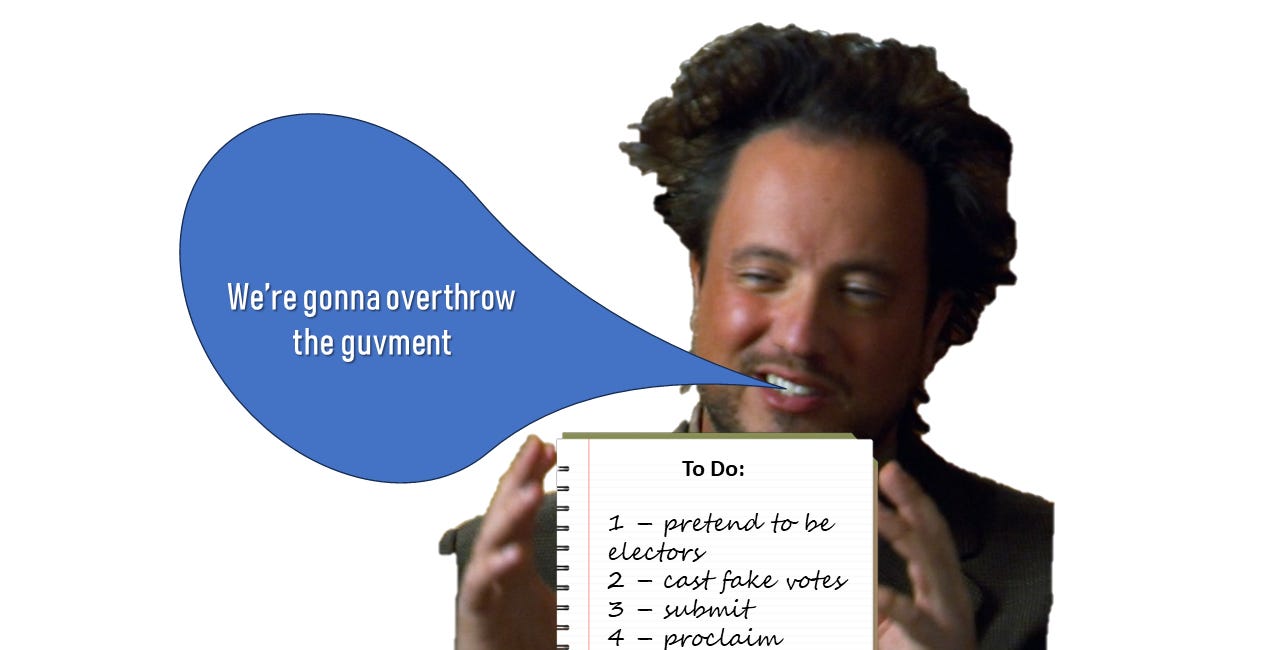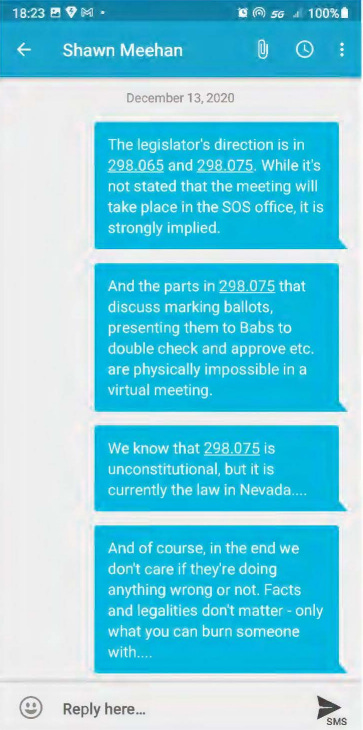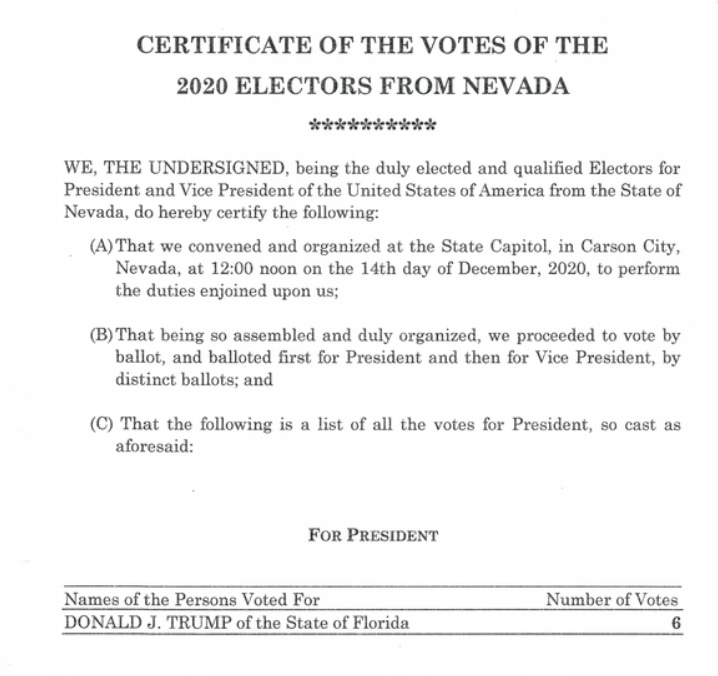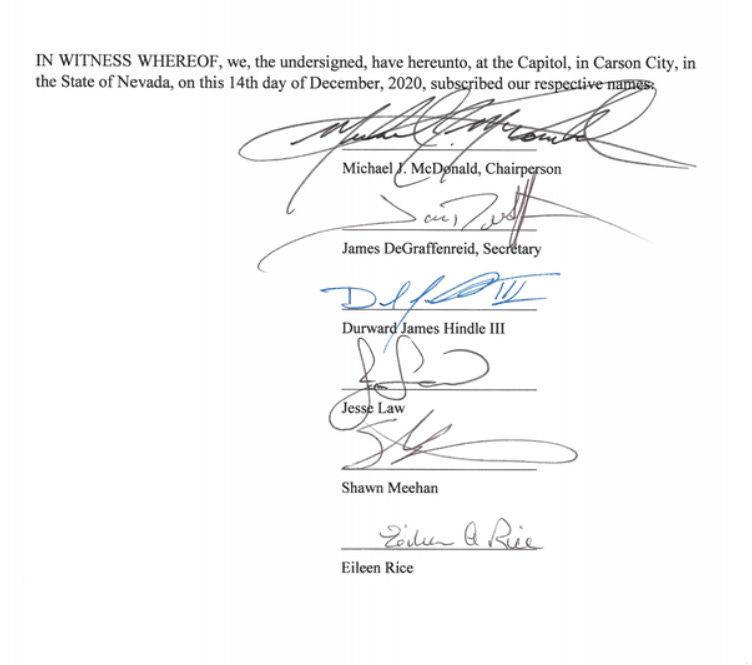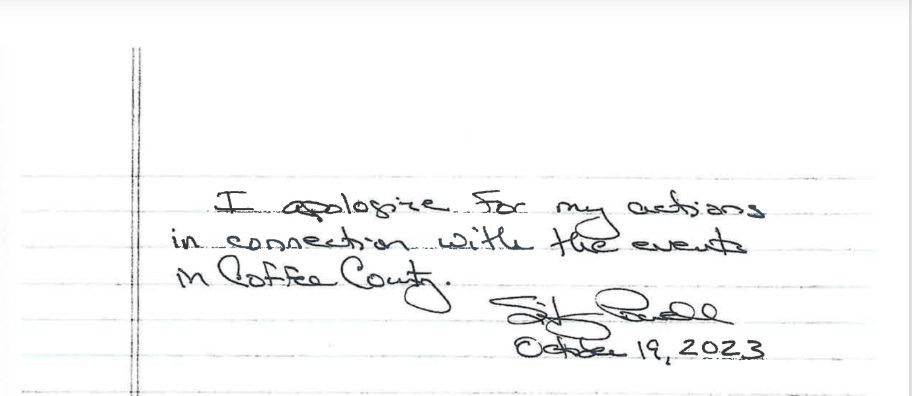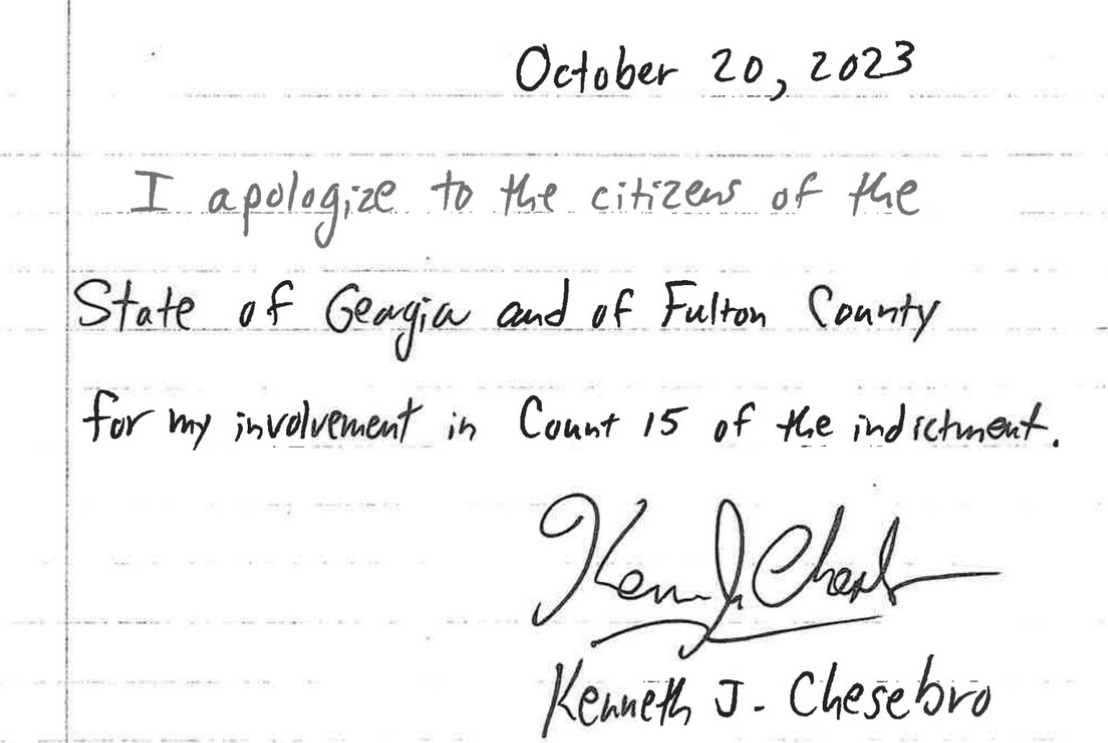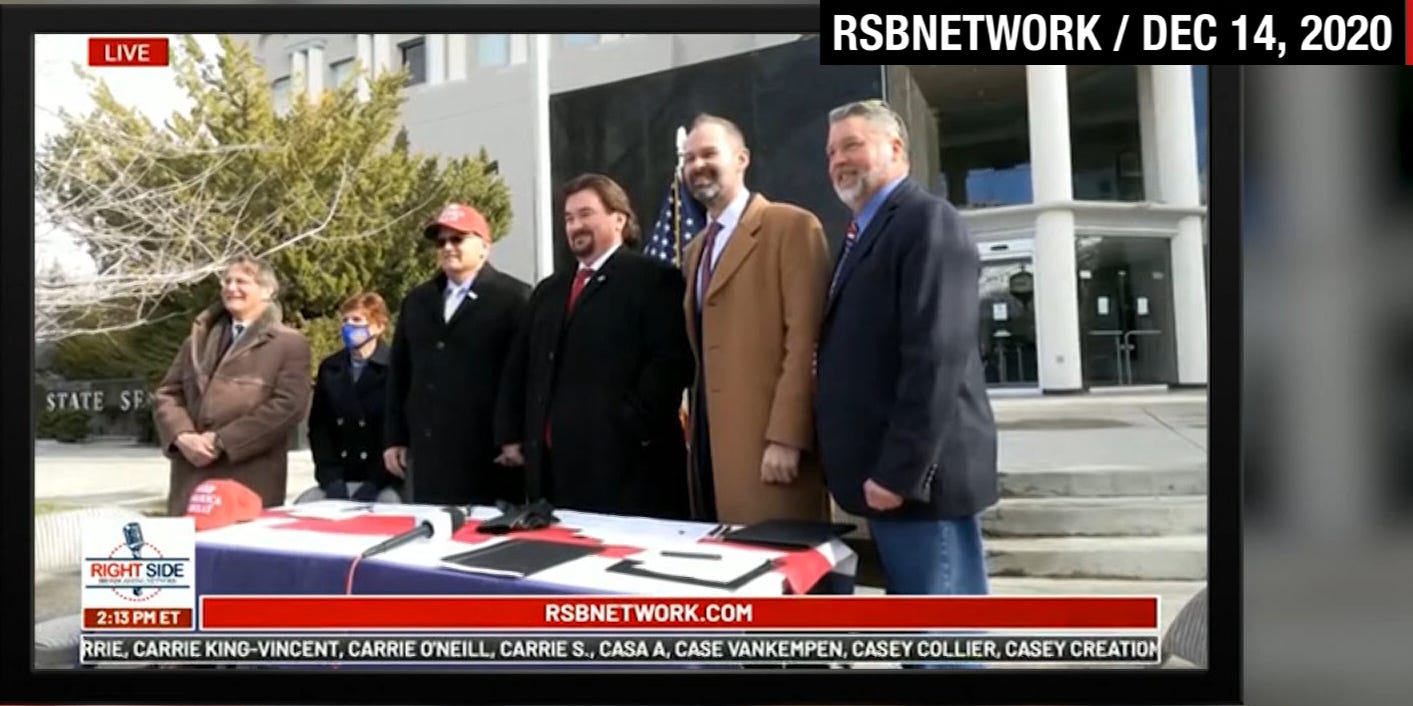More Traitors on the Dock
Six Nevada Republicans Criminally Charged for their Role in the Soft Coup
Visit the Evidence Files Facebook and YouTube pages; Like, Follow, Subscribe or Share!
Find more about me on Instagram, Facebook, LinkedIn, or Mastodon. Or visit my EALS Global Foundation’s webpage page here.
The Attorney General of Nevada recently charged six Nevada Republicans for their alleged attempt to contribute to Donald Trump’s criminal conspiracy to overthrow the United States government. Whether by force or by fraud, attempting to subvert an election to install a chosen person as the leader of a democratic country is a seditious conspiracy—an attempt to overthrow the government. Any other rendition is semantic gerrymandering. Like their foolish counterparts in Michigan, the following people are looking at the beginning of the end of their careers and, if justice is properly served, their freedom. The accused criminals are:
Michael McDonald - Nevada Republican Party Chairman
James DeGraffenreid - one of Nevada’s representatives to the Republican National Committee and a district-level delegate to the 2016 Republican National Convention
Durward James Hindle III - vice chair of the Nevada Republican Committee
Jesse Law - chairman of the Clark County Republican Party
Shawn Meehan - founder of Guard the Constitution Project
Eileen Rice - a longtime member of the Nevada Republican Party and delegate to the GOP national convention
These six Republicans are charged with Offering a False Instrument for Filing and Uttering Forged Instruments, C and D felonies respectively. The category C felony is punishable by up to five years in prison and a $10,000 fine, while the category D felony carries the potential for up to four years in prison and a $5,000 fine. If none have a previous criminal record, it appears unlikely any will receive prison time if found guilty of these charges, even though they should.
To understand the intent behind this alleged conspiracy, it is useful to remind readers how the election process for President works in the United States. The following passage first appeared in my article on the Michigan conspirators, Coup de Grâce:
The United States President is decided by votes from a body known as the Electoral College. According to Article II, Section 1 of the US Constitution, state party conventions choose their electors under rules that differ from state to state. After their state’s general election, these electors meet within the geographic boundaries of the state to cast their votes for President, typically—though not always—in line with the popular vote result. Each state has a number of electors set by its population, which is why some states are considered “swing states.” Swing states are important because the vote there often determines the outcome of presidential elections. Upon each state’s Secretary of State or Governor certifying the vote of the state, the raft of electors submit their vote tallies to the President of the Senate (the sitting Vice President of the USA), the Archivist of the United States, and the judge of the district in which they meet. To win the presidential election, a candidate must receive at least 270 of the 538 total possible votes. The President of the Senate’s sole job is to open the certificates in the presence of both Houses of Congress and count the votes. The Constitution lays it out as follows:
The President of the Senate shall, in the Presence of the Senate and House of Representatives, open all the Certificates, and the Votes shall then be counted. The Person having the greatest Number of Votes shall be the President
Because of the upheaval in the 2020 election, Congress has since clarified that the law does not permit him or her to “determine, accept, reject, or otherwise adjudicate or resolve disputes over the proper certificate of ascertainment of appointment of electors, the validity of electors, or the votes of electors.”
The presumption in the US criminal justice system is that defendants are innocent until found guilty by a judge or jury, or upon a voluntary plea of guilty. This article assumes that presumption of innocence, but from here on will mostly eschew the use of terms like “alleged,” “purported,” and so forth. Nonetheless, the evidence strongly indicates guilt.
Conspiracy in Nevada
Unlike the very detailed indictments filed by Special Counsel Jack Smith, the Nevada document offers no factual information. Regardless, a great deal of publicly available data exists to piece together the fact patterns that led to these indictments. Unfortunately for these fools, they essentially opened the door to prosecution by publicly presenting their forged document prior to falsely filing it with government offices. These defendants created a fake electoral document indicating that Trump had won the election in the state, then submitted the forgery to the National Archives and other authorities (the two crimes for which each is charged).
This hairbrained scheme commenced in much the same way the Michigan one did, under the direction of Trump’s cohorts, many of whom themselves have already been convicted of or pled to crimes, indicted, or accused by reference (not named). As the DC Indictment of Trump states,
Defendant and co-conspirators organized fraudulent slates of electors in seven targeted states (Arizona, Georgia, Michigan, Nevada, New Mexico, Pennsylvania, and Wisconsin), attempting to mimic the procedures that the legitimate electors were supposed to follow under the Constitution and other federal and state laws.
On this, I wrote:
These counts include a scheme to certify fraudulent electors in seven of the swing states, wherein party members in those states would attempt to pass forged electoral certifications to either overtake the lawful ones, or to disrupt the proceedings by sowing chaos and confusion.
The Trump campaign’s director of election day operations, Michael Roman, kept a record of the names and contact information of people who would act as fake electors in several states, including Nevada. This enabled other members of the Trump campaign to coordinate the criminal conspiracy with them. When the conspiracy planning began in Nevada is hard to pinpoint. The critical date for the execution of the Trump team’s plan was December 14th, the day the electoral votes had to be submitted, but organizing began long before.
On October 30, Nevada defendant Shawn Meehan sent a text to co-defendant James DeGraffenreid, stating "Been reading more on electoral college. If things get really sorted up, I could see Sisolak submitting one slate and Barbara having to send our slate. As she dislikes controversial situations, I wonder how that plays out" (McDonald Jan 6 Deposition p. 22). Meehan here meant that the Democratic governor of Nevada Steve Sisolak would send the lawful slate, but Republican Secretary of State Barbara Cegavske would send the false one if the chaos intended by Trump’s lawyers ensued; those lawyers were admitted felon Ken Chesebro and soon-to-be-disbarred and likely felon John Eastman. DeGraffenreid responded to Meehan that Cegavske would probably not submit a separate slate. In Nevada, if the Secretary of State submitted an “alternate” electoral slate such an act would violate Chapter 298 of its electoral law. When asked by the Jan 6 Committee for further context about this exchange McDonald pled the Fifth. The Jan 6 Committee also asked Chesebro about this: “[Chesebro’s] memo recognized that the [Nevada] secretary of state has to be… present for the meetings of electors. Do you know if anyone ever considered reaching out to secretary of state in Nevada to seek her participation [in the scheme to present an alternate electoral slate]?” (Chesebro Jan 6 Deposition, p. 49). Chesebro also pled the Fifth.
In a text message on November 4 between McDonald and someone identified only as Paula, he wrote “I have been on the phone this morning with the President, Eric Trump, Mark Meadows, and Mayor Giuliani. There is a major plan. We are meeting at the hotel with attorneys and national staff in about 20 minutes” [emphasis added] (McD Dep p. 13). Chesebro revealed the “major” plan publicly to the Talking Points Memo, saying “If you don’t know for sure the final result by December 14, it can be prudent to have multiple electors cast the ballot.” Chesebro and Eastman cared little about fraud—the excuse they were repeating at the time—but more about the “timing of the outcome and interest in sowing major upheaval.” Jason Miller, senior adviser to the presidential campaign at the time, restated this mantra in an email the day after the presidential race in Nevada was called for Joe Biden, writing “My understanding of our Nevada strategy is to cause as much chaos as possible." Campaign manager Bill Stipien replied, “If that’s the Nevada play, then okay.” To help foment this chaos, Nevada’s former GOP attorney general Adam Laxalt, and Jesse Binnall, a Trump campaign lawyer in Nevada, filed a lawsuit challenging the election results there. Laxalt and Binnall later “appeared at a press conference in mid-November 2020 to tout [the lawsuit]… and spread[][ claims of election fraud.”
On November 29, in another text message Meehan told DeGraffenreid, “we have a template for when we can plea ours and send it in ourselves when Sisolak refuses” (McD Dep p. 23). The template to which Meehan referred was provided in one of the memos written by Chesebro. Texts between Meehan and DeGraffenreid also indicate that they expected Laxalt and Binnall to lose the lawsuit, which is why they anticipated the need to submit their own slate without Governor Sisolak’s signature (DeGraffenreid text messages, pg. 1). The Jan 6 Committee asked McDonald if over the month of November did he and others prepare a plan to submit an alternative certificate to the National Archives. McDonald invoked the Fifth. The Jan 6 Committee asked Ken Chesebro, “Were Nevada and New Mexico chosen as vehicles to cast alternate electoral votes specifically because more electoral votes were needed to put President Biden's vote count beneath President Trump's?” He responded, “If I had any information about why the Trump campaign picked particular States to have alternate electors vote, I wouldn't be free to disclose that because it would be nonpublic and therefore privileged under attorney-client and 1.6, but also the subject matter is something that I'm taking the Fifth on” (Chesebro J6 Dep, p. 53).
The exact date on which Chesebro’s or Eastman’s memos made their way to any of these defendants is unclear. In any case, by the end of the first week of December, or possibly sooner, Trump’s co-conspirators were furiously sending emails and text messages or making phone calls to personnel in the seven battleground states to ensure that their confederates would forward the fraudulent electoral slates when all else inevitably failed. As discussed in my Coup de Grâce article in greater detail, Chesebro and Eastman drafted numerous memos that others later forwarded to contacts in the targeted states, laying out a fantasized legal theory for how states could ‘flip’ votes for Biden to Trump (Jan. 6 Final Report p. 344). On December 6, in an email circulated among Trump campaign personnel William Bock, Justin Clark, Matt Morgan, and Jenna Ellis, someone attached Chesebro’s November 8th memo and wrote: "Are steps being undertaken to ensure that Republican electors in Arizona, Georgia, Michigan, Nevada, Pennsylvania and Wisconsin cast their votes and transmit them as required on December 14th?" (Chesebro J6 Dep, p. 35). The message continued, “I expect this has likely already been addressed and the strategy determined, but I did not want to be negligent in failing to pass on Ken's [Chesebro] memo” (Chesebro J6 Dep, p. 36).
On December 9, DeGraffenreid wrote to co-defendants Meehan and (Durward) Jim Hindle that “we need to also decide if we're sending in our own ballot. Need to know which Senator and Congressman will make the objection. Cruz and Jordan maybe? What is the deadline for that?" (McD Dep. p. 24). In McDonald’s interview, the Committee wanted to know which Senator or Congressman the conspirators sought to recruit to file an objection to the legal slate Nevada’s governor would submit. McDonald again pled the Fifth. Later on December 9, DeGraffenreid texted Meehan and Hindle, “On line with legal right now. Attorneys and campaign have in mind to have the electors meet in Carson City Monday to cast our ballots and transmit to the Senate" (McD Dep. p. 25). This made it clear that DeGreffenreid was acting in direct concert with the Trump campaign and guiding his co-defendants to do the same.
The next day, Chesebro emailed DeGraffenreid stating that he would forward “drafts” of documents that the fake electors could use to “sign to effect their votes” for Trump. DeGraffenreid seems to have responded, though the response does not appear in the records. Regardless, Chesebro answered that response as follows:
I spoke this evening with Mayor Giuliani, who is focused on doing everything possible to ensure that that all the Trump-Pence electors vote on Dec. 14. He was glad to hear of your agreement with this strategy. As background, I attach my Nov.18 memo explaining the upside of this strategy, and, my Dec. 9 memo on the logistics, including the issues raised by state-law provisions regarding the Electoral College. You'll note that page 4 of the Dec. 9 memo mentions a concern regarding Nevada law, about the role of the Secretary of State. It may well be that the electoral vote needs to proceed without the participation of the Secretary of State, on the view that these technical aspects of state law are unlikely to matter much in the end. Of more practical use, attached are drafts of the Certificate that might be used on Dec. 14 [emphasis added], along with a form to use in filling vacancies, if any might arise. Also attached is a draft memo that could be mailed with the Certificates.
In terms of logistics, what's key is for the electors to assemble at the appointed time, and each personally sign the six (6) duplicate originals, make a copy of one of them (to convert to a PDF to circulate), and enclose each of them in an internal envelope, which will be tightly sealed, and labeled outside something like: "ELECTORAL VOTES OF THE STATE OF NEVADA FOR PRESIDENT AND VICE PRESIDENT OF THE UNITED STATES." This is the envelope that will then be opened only by the President of the Senate on January 6. Then, the four mailing envelopes would be addressed with the addresses I've listed in the memo. Pretty simple!
Chesebro made several key admissions here. First, he directly provided the documents at the center of the charges against these defendants. Remember that in his testimony to the Jan 6 Committee, Chesebro pled the Fifth when asked if he prepared any documents that would later be used in states Trump lost (Chesebro J6 Dep, p. 45). Second, he advised DeGraffenreid to break the law in this line of the email: “It may well be that the electoral vote needs to proceed without the participation of the Secretary of State, on the view that these technical aspects of state law are unlikely to matter much in the end.” Nevada’s election law section 298.065 explicitly states, “The Secretary of State shall preside at the meeting of presidential electors held pursuant to 3 U.S.C. § 7.” The vote could not legally “proceed without the participation of the Secretary of State.” Third, and most critically, he advocated for the Nevada electors to sign and submit forgeries that he himself drafted.
DeGraffenreid forwarded Chesebro’s email to Meehan, Hindle, Jesse Law (another co-defendant), and others asking, “What do we know about Ken? Is this a legit outreach?" (McD Dep. p. 29). Despite this apparent hesitancy, DeGraffenreid responded to Chesebro shortly thereafter with “Nevada is on board, and would appreciate you forwarding me whatever documentation you have that can help us.” Jesse Binnall later responded to DeGraffenreid’s inquiry about Chesebro stating he would “handle” the situation. Whether he meant to look into the legitimacy of Chesebro’s directives or that he would just do what Chesebro suggested is unclear. Whatever Binnall may or may not have done next, a day later Chesebro sent another email to several individuals connected to the Trump campaign and to the GOP. He wrote, "Attached are the seven documents I've prepared for Nevada. It sounds like it's in great shape. As mentioned to Mike Brown, who I am now copying on this thread, I was in email communication with Jim DeGraffenreid a couple of days ago and he was very responsive" (McD Dep. p. 30). On December 12, someone named Jeremy Hughes forwarded the same Chesebro email to McDonald, DeGraffenreid, and Jessica Hanson (the former executive director of the Nevada GOP). Hughes wrote, "Sounds like you all connected. Feel like everything is good?" (McD Dep. p. 31).
Later that day, another Chesebro email included language for the Nevada fake electors to use in a press conference:
Given that the results in Nevada are still in doubt, with legal arguments that have yet to be decided… so too the Republican electors should meet this year on December 14th as we await a final resolution of Nevada's six electoral votes. (McD Dep. p. 32)
The lawsuit challenging the election results in Nevada had already been dismissed a few days before that email. When the Committee asked McDonald why he believed the election results remained “in doubt,” he pled the Fifth. Moreover, McDonald pled the Fifth when asked whether he or the others sought legal advice related to asserting their own electoral slate. The same happened when asked whether he and the others discussed Nevada state laws pertaining to presidential elections or the role of electors.
On December 10th, someone forwarded an email written by Chesebro back in November to McDonald, DeGraffenreid, and others. The subject of that email was “What must happen on December 14th” (McD Dep. p. 36). The email again encouraged Republicans in Nevada to break the law:
Prudence dictates that the electors in each State who are pledged to Trump and Pence meet and cast their votes on December 14th. It may seem odd that the electors pledged to Trump and Pence might meet and cast their votes on December 14th even if, at that juncture, the Trump-Pence ticket is behind in the vote count and no certificate of election has been issued in favor of Trump and Pence. However, a fair reading of the Federal statutes suggests that this is a reasonable course of action. (McD Dep. p. 36)
Another email received on or around the same time, this one from Chesebro, conceded that the above instructions would ultimately violate the law:
Nevada is an extremely problematic State because it requires the meeting of the electors to be overseen by the Secretary of State, who is only supposed to permit electoral votes for the winner of the popular vote in Nevada… [Emphasis added] They make no sense when applied to this situation in which we are trying to have an alternate slate vote in hopes that its legitimacy will be validated before January 6th. Therefore, perhaps arguably, the Nevada electors could simply meet and cast their votes without the involvement of the Secretary of State... If there were a vote in Congress to take Nevada away from Biden and Harris, presumably along with it would come a vote to overlook this procedural detail (McD Dep. p. 37).
As mentioned above, proceeding without the Secretary of State in Nevada would unequivocally violate the law. Additionally, Nevada law prohibits electors choosing the candidate who did not win the popular vote in the state. Chesebro knew this but advised the fake electors to carry out their scheme regardless. Moreover, the schemers also employed an election law attorney in the state (Binnall) to whom they forwarded all the items received from Chesebro, so they undoubtedly knew this would violate the law. Indeed, the memo attached to that email explicitly said so:
It appears that… most of the electors (with the possible exception of the Nevada electors) will be able to take the essential steps needed to validly cast and transmit their votes… without any involvement by the Governor or any other State official except in Nevada where the Secretary of State is involved [Emphasis added] (McD Dep. p. 39).
They were banking on seditious members of Congress to somehow “take away” the Nevada vote from the Biden-Harris ticket, something no Congress member—including the Vice President—had the authority to do. Chesebro told them:
the purpose of having the electoral votes sent in to Congress is to provide the opportunity to debate the election irregularities in Congress, and to keep alive the possibility that the votes could be flipped to Trump and Biden.
When asked about this, McDonald again pled the Fifth.
In the days before the December 14 vote, Trump actively involved himself in encouraging the fake electors to commit their crimes. He and Giuliani called Ronna McDaniel, the Chair of the Republican National Committee, to ensure that the party apparatus deployed resources in battleground states to convince co-conspirators to engage in these fake elector schemes. Back on December 8, a court threw out the specious lawsuit filed by former GOP attorney general Adam Laxalt, and Jesse Binnall. The Nevada GOP’s lawyers called RNC lawyers to concoct some other method to again challenge the election results. Notably, despite more than 60 cases filed to challenge election results across the country, no court found merit in any of them. And some led to the lawyers filing them to receiving sanctions from their bar associations because the cases were unquestionably frivolous.
Two days before the scheduled electoral vote, DeGraffenreid texted his co-conspirators acknowledging that the court cases failed, writing “Just FYI, national wants to kill going to the Supreme Court. Doing another call in the AM, and they don't want press or rallies on Monday. Not sure why” (McD Dep. p. 49). Law, one of the co-defendants, sent a text the next day to DeGraffenreid exhibiting the growing sense of foreboding among the party about partaking in the crime the following day: “Suddenly mixed messages and direction on publicity for tomorrow. Not pleased that was raised on the call and not with me beforehand. Upset chairman” (McD Dep. p. 51)—note that the chairman here refers to McDonald. When asked about this, McDonald pled the Fifth. Meehan also indicated concern for the crime they were about to commit the next day. He wrote to DeGraffenreid:
[Jim Hindle] also said that since we are not the official electors this is a politicized meeting not an official meeting so we can not use the facility anyway. True or not, makes sense sadly… We just have to meet is all required, right? In Carson City is only requirement[?] Not certain building? NVSOS [Nevada Secretary of State] not being there dorks it up too. [DeGraffenreid text messages, pg. 5]
Meehan complained to DeGraffenreid about the RNC’s role in all this. “He’s [McDonald] stressing on the optics. He’s very concerned RNC will cut cord if [it] looks bad and steal credit if we do well. He’s concerned that we look like foolish crybabies” (McD Dep. p. 58-59). Both of them knew what they planned to do was illegal and opined about the RNC leaving them to take the blame if the scheme failed. DeGraffenreid texted about it at length to Meehan, even citing the relevant sections of Nevada law.
DeGraffenreid text messages, pg. 6
Nevertheless, the defendants the next day went through with their criminal conspiracy. They met in Carson City, conducted their illegal “vote,” drafted their forged electoral certificate, and sent it to the National Archives, the Senate, and other authorities.
Source: American Oversight
The document begins with a falsified statement, “duly elected and qualified electors.” As the abundance of evidence indicates, they were neither and they knew it. By filing this document with the various authorities, they committed the crimes of filing a false instrument and uttering a forgery. On December 18, four days after their fraudulent “vote,” Meehan vented his frustration over the failure of their silly plan and predicted that some violence might occur.
Makes me wonder if a Patriot out there aware of the theft might take a Second Amendment approach to solving the problem. I certainly don't want violence, but the Battle of Athens in 1946 shows this is why the Second Amendment exists. I'm just baffled at the flippant attitude of the courts. To be clear for the NSA technicians reading this text, I do not want, nor am I advocating for violence. I'm simply calling out that there likely are others out there with far less impulse control in light of this tyranny. [DeGraffenreid text messages, pg. 10]
To their credit, both decried the violence that occurred on January 6. They did not, however, acknowledge their role in that event by continuously spreading lies about a “stolen” election for which their own lawyers could not provide an iota of evidence. Their mere belief in the stolen election provided them the predicate to commit their crimes.
Justice Failure
Make no mistake, Michael McDonald, James DeGraffenreid, Durward James Hindle III, Jesse Law, Shawn Meehan, Eileen Rice, Ken Chesebro, Rudy Giuliani, and Donald Trump—among many, many others—engaged in a conspiracy to defraud the voters of Nevada and the United States at large. Each of these individuals knowingly partook in conduct to circumvent the law and the election to install Trump to an office he neither won nor deserved. Plainly and simply, they attempted to overthrow the United States Government by targeting the highest office of the land for their subversion. Federally, the only one charged so far for this broad-based scheme is Trump himself. And even those charges do not specifically account for the seditious conspiracy. This weak-kneed approach to justice is a categorical failure. Part of the purpose of punishment in the criminal justice system is to deter others from engaging in the same prohibited conduct. Instead of locking these people away for life as they deserve, so far most have gotten away with slaps on the wrist by writing disingenuous letters of apology or shedding petty theatrical tears.
Jeff Tiedrich summed up these letters perfectly:
handwritten notes on a legal pad? who knew that was even a thing.
these apologies were written with all the sincerity of two teenagers forced to apologize for leaving a flaming bag of dog shit on their neighbor’s porch.
who knew that you could get away with half-assing that shit as part of a get-out-of-jail-free card after trying to subvert an election.
at least try to spell “Georgia” correctly, Cheese.
Here, you can watch Jenna Ellis’s faux tears shed at her allocution.
In a country where more than “two-thirds of people serving federal life or virtual life sentences today were convicted of nonviolent crimes,” how is that a cadre of people who attempted to overthrow the government continue to receive probation or extraordinarily light sentences? In the US Constitution, the only crime explicitly defined is treason. The drafters of the document determined that the gravest offense one could commit in the United States was to “adher[e] to [the] enemies [of the United States], giving them aid and comfort.” Aside from taking up arms against the country itself, the only other form of treason a person can conduct is to attempt to overthrow the government from within. Trump, who was the sitting President at the time of this conspiracy, once took an oath that says:
I do solemnly swear (or affirm) that I will faithfully execute the Office of President of the United States, and will to the best of my Ability, preserve, protect and defend the Constitution of the United States.
He did none of these things.
The Treason Clause says:
Treason against the United States, shall consist only in levying War against them, or in adhering to their Enemies, giving them Aid and Comfort....
These conspirators gave “aid and comfort” to plotters attempting to subvert the election in order to install a single person to arguably the most powerful office in the world. The sitting President, who took an oath to protect and defend against such sedition, participated in the scheme. In 1951, the Supreme Court noted the weight with which Congress viewed this kind of behavior:
Congress was concerned with those who advocate and organize for the overthrow of the Government. Certainly those who recruit and combine for the purpose of advocating overthrow intend to bring about that overthrow… The obvious purpose of the statute is to protect existing Government, not from change by peaceable, lawful and constitutional means, but from change by violence, revolution and terrorism.
The Treason and Seditious Conspiracy statutes contain a “violence” element, which is probably why the majority of conspirators in various jurisdictions have not been charged with these crimes. But, the long history of law going all the way back to the framing of the Constitution comported great significance to the notion of betrayal. The 2nd Circuit explained it clearly:
Treason "imports a betraying." Blackstone, too, noted that treason, "in it's [sic] very name… imports a betraying, treachery or breach of faith." Early on, our Supreme Court recognized that." [Citations omitted]
United States Code Title 18 § 2385 prohibits one who “advocates, abets, advises, or teaches the duty, necessity, desirability, or propriety of overthrowing or destroying the government of the United States.” That statute also includes violence as a necessary element. Nevertheless, in enacting that law Congress recognized that one need not actually engage in violence to still qualify for punishment for advocating the overthrow of the government. In Dennis v. United States, the Supreme Court elucidated the difference between “discussion” and “advocacy,” with the latter comprising the unprotected speech accounted for in § 2385. In 1986, the 7th Circuit Court of Appeals had this to say about conspiring to overthrow the United States Government:
Section 2384 [the Seditious Conspiracy statute] has no requirement of the duty of loyalty, fidelity or allegiance to the United States. Unlike treason, seditious conspiracy does not extend beyond United States jurisdictional boundaries. It does not contemplate the presence of an enemy foreign state or an actual war. Finally, Section 2384 requires at least two persons to commit the offense… Section 2384 provides a vehicle for the government to make arrests before a conspiracy ripens into a violent situation. The government's interest in thwarting such plans and in safeguarding public security is unquestioned. [Emphasis added]
The public knows that the conspiracy outlined herein ultimately led to a “violent situation.” Donald Trump alone faces charges resulting in the culmination of it. That these six Nevada Republicans only face what Republican politicians love to call “process crimes” is a travesty of justice. Failing to tackle this massive conspiracy for what it really was will only empower others to attempt it again.
Seditious Conspirators. Source: CNN
***
I am a Certified Forensic Computer Examiner, Certified Crime Analyst, Certified Fraud Examiner, and Certified Financial Crimes Investigator with a Juris Doctor and a Master’s degree in history. I spent 10 years working in the New York State Division of Criminal Justice as Senior Analyst and Investigator. Today, I teach Cybersecurity, Ethical Hacking, and Digital Forensics at Softwarica College of IT and E-Commerce in Nepal. In addition, I offer training on Financial Crime Prevention and Investigation. I am also Vice President of Digi Technology in Nepal, for which I have also created its sister company in the USA, Digi Technology America, LLC. We provide technology solutions for businesses or individuals, including cybersecurity, all across the globe. I was a firefighter before I joined law enforcement and now I currently run a non-profit that uses mobile applications and other technologies to create Early Alert Systems for natural disasters for people living in remote or poor areas.
Click below to read Tiedrich’s entire piece cited above:




